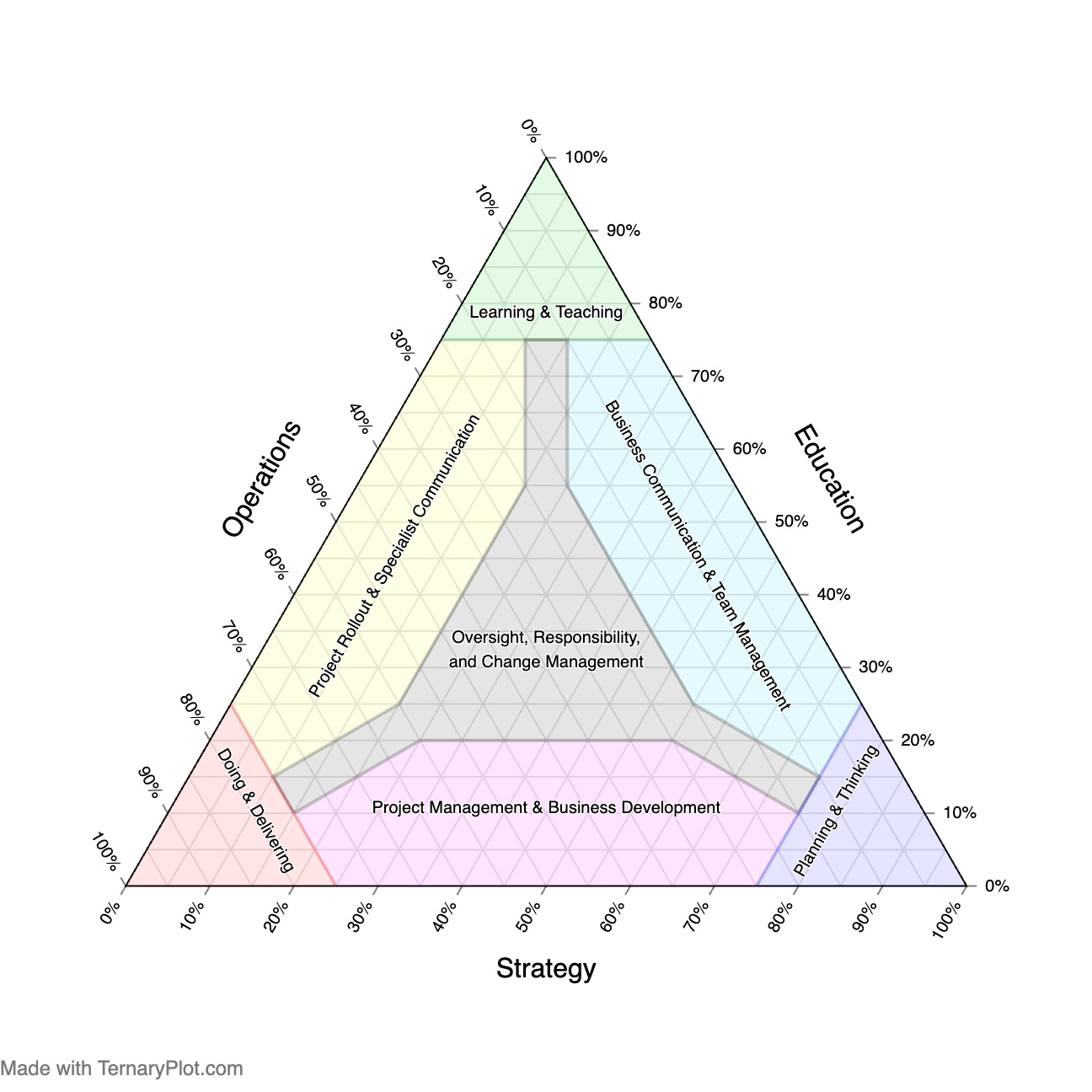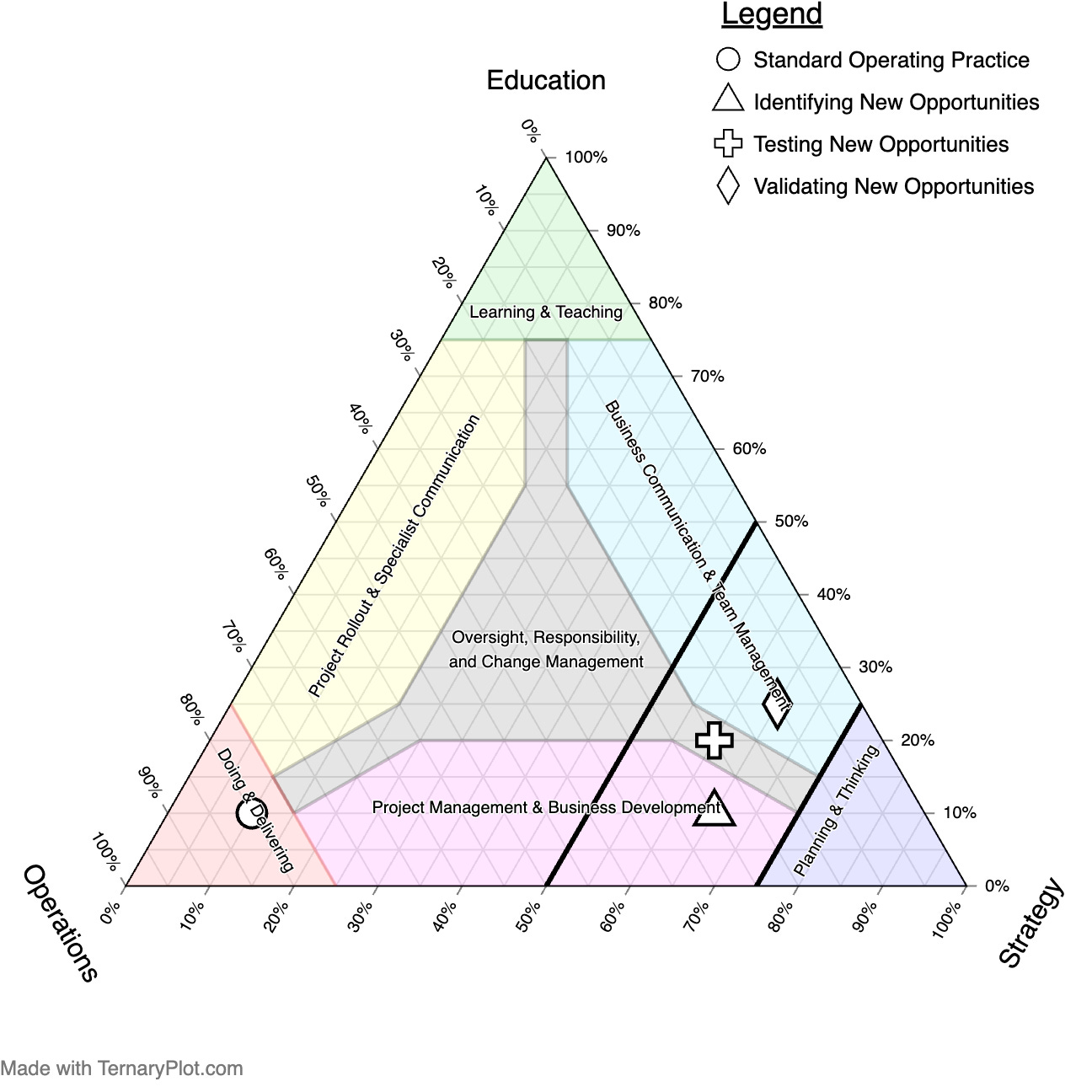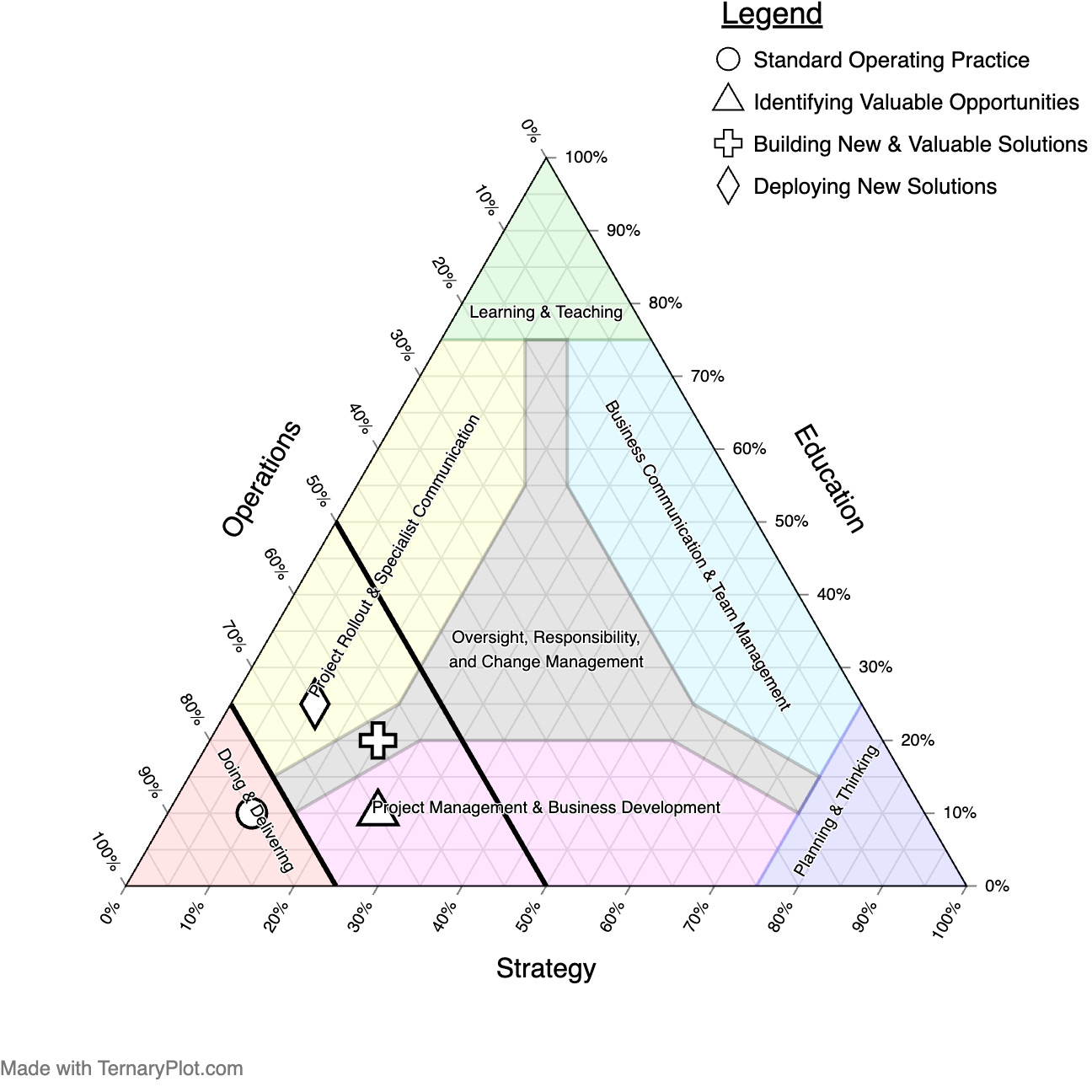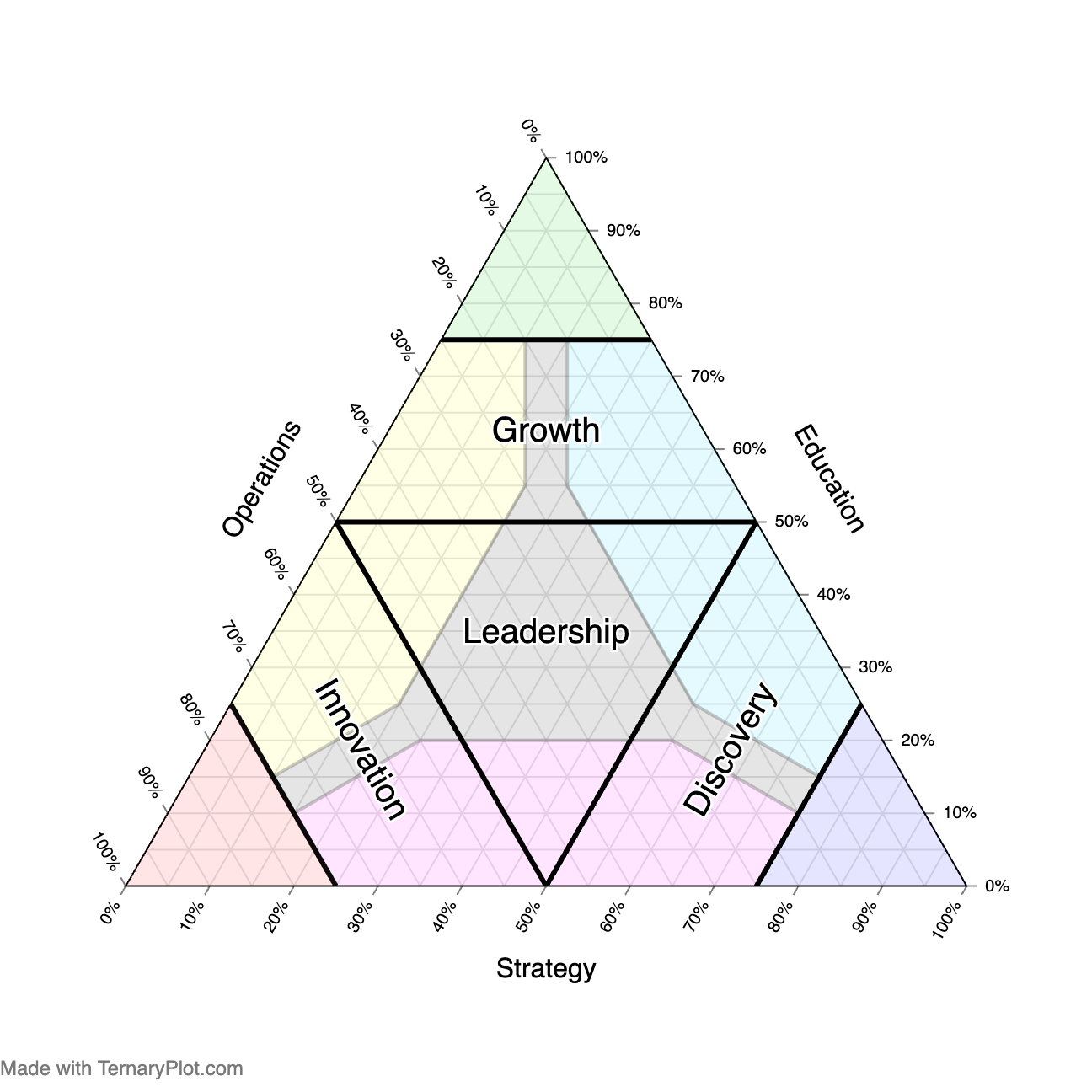Finalising the Business Trinity Compass: A guide for your career journey.
Discovering the final component of the compass by placing the activities of the "Cycles of Discovery and Innovation"
In previous posts we have introduced the Business Trinity Theory, the Business Trinity Compass, and the Cycles of Discovery and Innovation. You can find these posts here:
In this post we are going to extend, and finalise, the Business Trinity Compass. This discovery is made by placing the activities associated with the Cycles of Discovery and Innovation on the compass; identifying areas that highlight the associated core business activities.
We are going to assume you are familiar with the Business Trinity Theory, and The Cycles of Discovery and Innovation; so you may want to read those posts ahead of this one – or look at our “TL;DR” section to see if there is a shortened summary of these posts and topics.
Let’s dive into combining these concepts and unlock the final component of the Business Trinity Compass.
Refreshing the memory
To start, let’s show “The Cycles of Discovery and Innovation” with the “Business Trinity Compass” for reference
Breaking down “The Cycles of Discovery and Innovation”
Now let’s break down steps into the expected core components as outlined by the Business Trinity Theory (Operations, Education, Strategy)
First, we’ll place “Standard Operating Practice” which has the expected breakdown: {Operations: 80%, Education: 10%, Strategy: 10%}; placing it squarely into the “Doing & Delivering” focused zone on the Business Trinity Compass.
As with all the breakdowns we provide on The Technician’s MBA, these are what we expect to see, and cover the main day to day focus rather than a gospel as businesses vary.
To enable us to identify the final component of the Business Trinity Compass, let’s place the expected breakdown for each of items in the Cycles of Discovery and Innovation onto the compass and see what happens.
Cycle of Discovery
We start with discovery because, as we said when we introduced these cycles, the order should always be discovery then innovation to minimise the risks of wasting time and resources. The breakdown of the core components will most likely be something like this:
Identifying New Opportunities:
{Operations: 25%, Education: 10%, Strategy: 65%}
Testing New Opportunities:
{Operations: 20%, Education: 20%, Strategy: 60%}
Validating New Opportunities:
{Operations: 10%, Education: 25%, Strategy: 65%}
We now plot these points on the compass, with bands to indicate the potential variation in these values.
You can see that the expected core components stay in the bottom right, delivering additional value associated with the focused zone “Planning and Thinking”.
Cycle of Innovation
Lastly we’ll look at how we would place the Cycle of Innovation on the Business Trinity Compass; with expected breakdowns for each of the steps in the cycle being:
Identifying Valuable Opportunities & Solutions:
{Operations: 65%, Education: 10%, Strategy: 25%}
Building New & Valuable Solutions:
{Operations: 60%, Education: 20%, Strategy: 20%}
Deploying New Solutions:
{Operations: 65%, Education: 25%, Strategy: 10%}
Again we can plot these points on the compass, with bands to indicate the potential variation in these values.
You can see these inhabit the bottom left of the compass delivering additional value associated with the focused zone “Doing and Delivering”.
As you can see, the activities of the Cycles of Discovery and Innovation inhabit small regions of the Business Trinity Compass; and typically they always will.
From this we discover the last component on the compass: areas. We can classify these bands into areas describing the wider objective or responsibility that the points are trying to achieve.
Areas of The Business Trinity Compass
So, through plotting the component breakdowns of the Cycles of Discovery and Innovation we unlock “areas”; which provide a way to start thinking about the activities and their associated component breakdowns.
We already have already have points, zones, show now let's show areas.
When combined, these three aspects of the compass provide a fairly comprehensive view of business activities, completing the definition.
The areas only cover the central zones of the compass, ignoring the focused zones as they are singularly focused extensions of their neighbouring areas. i.e. we saw in the previous post that Standard Operating Practice is in the zone neighbouring Innovation, as it is purely focused on delivery i.e. “Doing and Delivering”
The central area “Leadership” highlights that points in this area typically relate to leadership activities; which are more wide ranging and less “focused” than the other areas. As a leader you are going to have to jump between all aspects on the Compass, but it is rare that you will ever go back into solely focusing on one component again; your job becomes ensuring the environment is the best it can be to support everyone’s activities on the compass.
Within the Business Trinity Compass, areas define classifications of responsibilities and objectives; so let’s state these for clarity:
Areas of The Business Trinity Compass (Responsibility - Objective)
Leadership - Be a Leader: Activities in this area will focus on ensuring the business reaches its goals.
Growth - Drive Growth: Activities in this area focus on providing growth opportunities for both the business and its employees.
Discovery - Enable Discovery: Activities in this area focus on discovering new opportunities that the business can utilise.
Innovation - Deliver Innovation: Activities in this area focus on building and deploying new methodologies within the business.
Why extend the Business Trinity Compass?
The business trinity compass is already quite a complicated concept; why would we add more to it?
Think of it this way. Zones on the Business Trinity Compass are more specific than areas which allow us to visualise:
The expected range for the core components
The types of activities we are likely to do
The outcomes we are likely to see
What other activities we might need to consider from adjacent zones.
Areas are classifications of broader business activities which allow us to visualise these points on a broader scale. This provides additional value over the zones as the areas provide a way into start thinking about the activities and the component breakdowns.
Say for example you want to drive growth; well that means we want to think about spending the following breakdowns in our components
Operations: 25% - 50% of our time
Education: 50% - 75% of our time.
Strategy: 25% - 50% of our time.
Knowing this we are then able to think about the types of activities in the following zones: Oversight, Responsibility, and Change Management; as well as potential activities in the adjacent Learning & Teaching Zone to support our “Growth” objective.
The Business Trinity Compass
With that the definition of the Business Trinity Compass is complete.
The Business Trinity Compass is a framework that can be used to help break down larger goals into more manageable pieces; getting us to think about roles, projects, and objectives that will help us realise our goals.
The reason that this the post series was chosen to kick of The Technician’s MBA is because from listening to those I mentor, this is an area that isn’t taught to them as they progress in seniority: how to plan and think about activities in the wider business ecosystem.
I wanted to introduce a way of thinking that can help, highlight how key business activities can be placed on the compass, and use that to show the value in this way of thinking.
As with all frameworks, they are tools that you should use to help on your business journey. From my experience, thinking about activities in this way has helped massively across both junior and senior positions. This is because it helps to both: prioritise your time, and understand the surrounding activities. Business activities and teams don’t operate in a vacuum, the Business Trinity Compass helps you visualise the whole picture and how activities help towards the business’ goals.
Keep an eye out for TL;DR for The Business Trinity compass which provides a singular view. I know that introducing it over three posts makes it more difficult to piece everything together; however, given the level of thinking and detail behind the compass I wanted to guide you through the definition in a way that made it clear why each aspect exists.
Make sure you are subscribed to get notified so you don’t miss these or other posts when posts go live every Wednesday!
Let us know if and how you use the Business Trinity Compass, or if you have any questions, in the comments. See you next Wednesday for a new post, and keep an eye out for the next TL;DR.
Grand. Thanks for your time.









